Introduction
Birdwatching is a popular pastime that allows us to connect with nature and enjoy the beauty of the avian world. Two of the most captivating birds often seen in North America are the Blue Grosbeak and the Indigo Bunting.
While they share some similarities, these two species are distinct in many ways. Understanding these differences can enhance your birdwatching experience and help you appreciate these creatures even more.
What is a Blue Grosbeak?
Description and Physical Characteristics
Particularly in males, the Blue Grosbeak (Passerina caerulea) has remarkable deep blue plumage. They mainly eat seeds; thus, their big, broadbills are made for shattering them. While females and juveniles are primarily brown with faint blue tinges, males have a vivid blue body with bars of chestnut colour on their wings.
Habitat and Distribution
During the breeding season, blue grosbeaks are usually found in the southern United States; in the winter, they migrate to Central America. Their preferred habitats include open forests, pastures with shrubs, and places next to bodies of water.
Behavioural Traits
Known for their lovely voices, blue grosbeaks are frequently heard singing during the breeding season. Males sing to defend their territory and entice females during this time when they become territorial. They hunt for seeds and insects in low vegetation, which make up the majority of their diet.
You May Also Like: Should You Feed Birds in Summer?
What is an Indigo Bunting?
Description and Physical Characteristics
Another eye-catching bird is the Indigo Bunting (Passerina cyanea), which is well-known for its vivid blue colourings in males. Males become a solid blue colour during the breeding season, whereas females and non-breeding males have more subdued, brownish tones. Compared to the Blue Grosbeak, the Indigo Bunting is smaller and has a more slender build.
Habitat and Distribution
Indigo buntings are found all around North America, but particularly in the east during nesting season. During the winter, they move to Central and South America. These birds are frequently seen in forest clearings, open fields, and brushy margins.
Behavioural Traits
In addition, Indigo Buntings are well-known for their lovely songs, which consist of a range of high-pitched notes. During the breeding season, they still defend their territory, but they are not as fierce as Blue Grosbeaks. They share a similar diet of berries, seeds, and insects.
Comparison of Physical Characteristics
Size and Shape
Generally speaking, the Blue Grosbeak is larger than the Indigo Bunting, possessing a more muscular physique and a notably thicker bill. In comparison, the Indigo Bunting has a finer beak and is smaller and more delicate-looking.
Coloration and Plumage
Although the plumage of both species is blue, the Blue Grosbeak’s is more intense, especially around the head and upper body. The blue of the Indigo Bunting is more vibrant and consistent across its body. Both species’ females are more subdued in appearance; however, the female Blue Grosbeak is warmer and browner in tone than the female Indigo Bunting is greyish-brown.
Seasonal Changes
Both species show seasonal variations in plumage, with the Indigo Bunting showing the most. Males change to a brownish colour outside of the breeding season. Male Blue Grosbeaks never lose their blue colouring entirely. However, they may be duller in the winter.
Habitat and Range
Blue Grosbeak Habitat
During the breeding season, the southern and central regions of the United States are usually home to blue grosbeaks. Their preferred habitats include fields, woodland margins, and places with power lines and plenty of bushes.
Indigo Bunting Habitat
During the nesting season, Indigo Buntings can be found in more significant numbers throughout the eastern United States. They are frequently observed in fields, roadsides, and open forests.
Overlapping Regions
Indigo Buntings and Blue Grosbeaks occasionally overlap their habitats, particularly in the country. Both species can occasionally be seen in the same settings in these regions despite the modest variations in their preferred nesting and eating sites.
Migration Patterns
Due to their migration, both species, Indigo Buntings and Blue Grosbeaks, winter in South America and Central America, respectively. Both species migrate throughout the same seasons, which happen to coincide with spring and autumn.
You May Also Like: Top 11 Blue Birds in California
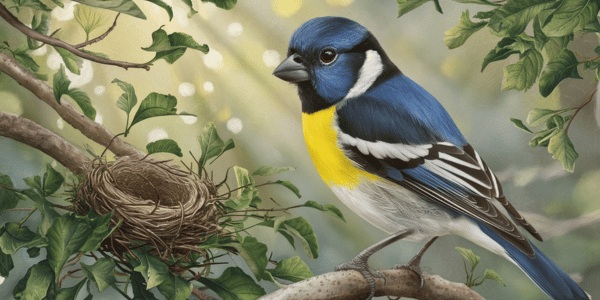
Behavioural Differences
Feeding Habits
While seeds and insects are the primary sources of food for both birds, their methods of foraging can vary. While Indigo Buntings are sometimes sighted higher up in the foliage, they are more frequently observed foraging in low vegetation or on the ground, mainly when they are feasting on berries or small fruits.
Mating Rituals and Nesting
Known for their intricate songs, Blue Grosbeaks are essential for both defending their territory and luring mates. They construct their nests in low trees or thick bushes. Though they are likewise melodious, indigo buntings have a less complex courtship display. They may select slightly more open areas, but they tend to nest in similar habitats.
Territorial Behavior
During the breeding season, both species are aggressive in protecting their territories, although the Blue Grosbeak tends to be more so. Even though they are territorial, indigo buntings don’t usually fight.
Vocalizations and Songs
Blue Grosbeak Songs
The Blue Grosbeak’s song is described as a combination of trills and warbles, and it is rich and varied. During the breeding season, males sing a lot to mark their territory and entice a mate.
Indigo Bunting Songs
Short, paired notes make up the lovely, high-pitched song of the Indigo Bunting. These songs are frequently repeated and used for mate attraction and territory defence.
How to Differentiate by Sound
It can be challenging to distinguish between these birds based solely on their songs, but generally speaking, the Indigo Bunting’s song is more straightforward and more repeated than the Blue Grosbeak’s. This is an essential identification tool for birdwatchers.
Breeding and Reproduction
Blue Grosbeak Breeding Patterns
Blue grosbeaks typically breed in late spring or early summer. They usually raise two broods per season and build their nests in low trees or dense shrubbery. The female does most of the nest construction and incubation.
Indigo Bunting Breeding Patterns
Indigo Buntings begin breeding in late spring. Though some may try for a second brood, they typically only have one per season. Similar to the Blue Grosbeak, these birds build their nests primarily in tiny trees or bushes, with the female taking the lead in doing so.
Nesting Sites and Materials
Both species use similar nesting materials, like grasses, twigs, and leaves. However, blue Grosbeaks frequently use a wider variety of materials, such as paper and even bark strips.
Conservation Status
Current Population Trends
Because of their steady population trends, blue grosbeaks and indigo buntings are not currently listed as endangered. However, environmental variables such as habitat degradation may have an impact on their populations.
Threats to Their Habitat
The degradation of habitat is a serious threat to both species, especially in locations where they nest. Three main issues that could affect their populations are urbanization, agriculture, and deforestation.
Conservation Efforts and Measures
Conservation efforts aim to preserve these birds’ native habitats, especially in locations where they nest and winter. Organizations fight to protect the borders of forests, shrublands, and open spaces because these habitats are essential to their survival.
You May Also Like: Can Birds Eat Popcorn?
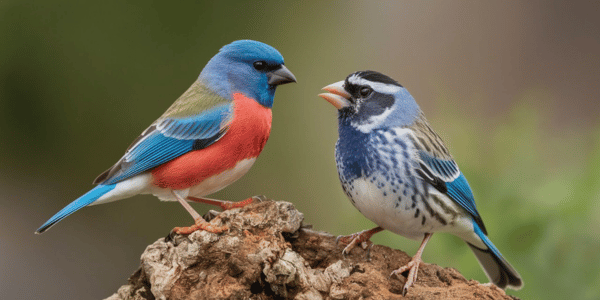
Blue Grosbeak vs Indigo Bunting: Which One to Spot in Your Backyard?
Attracting one of these species to your backyard can be a rewarding experience for birdwatchers. Provide areas with open ground for foraging and dense shrubs to draw Blue Grosbeaks. Provide a variety of seeds and keep open spaces with sporadic trees or bushes for Indigo Buntings. Bird feeders, particularly ones filled with millet and sunflower seeds, are appreciated by both species.
Similar Species and How to Tell Them Apart
Other birds, like the Eastern Bluebird or Lazuli Bunting, can be mistaken for Blue Grosbeaks and Indigo Buntings. Nonetheless, essential distinctions such as the size, shape, and pattern of colouration of the bill might aid in accurate identification.
Impact on Ecosystem
Role in the Food Chain
Both Indigo Buntings and Blue Grosbeaks are crucial seed dispersers and bug controls in their respective environments. Their eating patterns contribute to the equilibrium of insect and plant populations.
Importance to Biodiversity
These birds sustain a healthy ecosystem by adding to the biodiversity of their habitats. Their existence suggests a healthy environment that is abundant in food supplies and suitable nesting sites.
Characteristics Table of the Blue Grosbeak and Indigo Bunting
| Characteristic | Blue Grosbeak | Indigo Bunting |
|---|---|---|
| Scientific Name | Passerina caerulea | Passerina cyanea |
| Male Plumage | Deep blue with chestnut wing bars | Bright, uniform blue |
| Female Plumage | Brown with subtle blue tints | Grayish-brown |
| Migration | Migrates to Central America | Migrates to Central and South America |
| Song | Rich, varied, warbles and trills | Sweet, high-pitched, paired notes |
| Nesting Sites | Dense shrubs, low trees | Shrubs, small trees |
| Breeding Season | Late spring to early summer | Late spring |
| Number of Broods | Often two per season | Usually one, sometimes two |
Cultural Significance and Symbolism
Blue Grosbeak in Folklore
In several cultures, the blue grosbeak is revered as a symbol of protection and watchfulness. Because of its striking blue colour and commanding presence, it is a bird of significance in many myths and folklore.
Indigo Bunting in Culture
Because of its cheery look and catchy singing, the Indigo Bunting is frequently linked to happiness and simplicity. It has been portrayed as a joyous and liberating emblem in literature and art.
Symbolism in Art and Literature
Both birds have been portrayed in literature and art, frequently signifying various facets of nature and life. The Indigo Bunting signifies beauty and tranquillity, whereas the Blue Grosbeak can stand for strength and perseverance.
You May Also Like: The Top 5 Yellow-Breasted Birds in Texas
Conclusion
In looking at the Blue Grosbeak and the Indigo Bunting, it is apparent that while the two species share similitudes in their eating routine, conduct, and lively blue plumage, they additionally display unmistakable contrasts in size, territory inclinations, and movement designs. These fascinating birds, each of which contributes to the rich tapestry of avian diversity, can be appreciated by both bird enthusiasts and researchers for their singular beauty and ecological functions.
FAQs: Blue Grosbeak vs Indigo Bunting
1: What is the main difference between a Blue Grosbeak and an Indigo Bunting?
Their size, colourings, and preferred habitats are where they diverge most. Indigo Buntings are smaller and have brighter blue plumage than Blue Grosbeaks, which are larger and have a darker blue colour.
2: Can Blue Grosbeaks and Indigo Buntings be found in the same regions?
Yes, there may be an overlap between their habitats, especially in the southeast of the country. Nevertheless, they might like somewhat varied settings within these areas.
3: What do Blue Grosbeaks and Indigo Buntings eat?
Both species’ main foods are berries, seeds, and insects. Indigo Buntings are found in higher foliage, while Blue Grosbeaks are typically found closer to the ground. They forage in distinct places.
4: Are Blue Grosbeaks or Indigo Buntings endangered?
At the moment, neither species faces extinction. Although their populations are stable, future dangers may arise from habitat loss.
5: How can I attract Blue Grosbeaks and Indigo Buntings to my backyard?
Plant bushes in dense growth and provide open spaces with seed-filled bird feeders. Both species value environments that offer cover and chances for foraging.

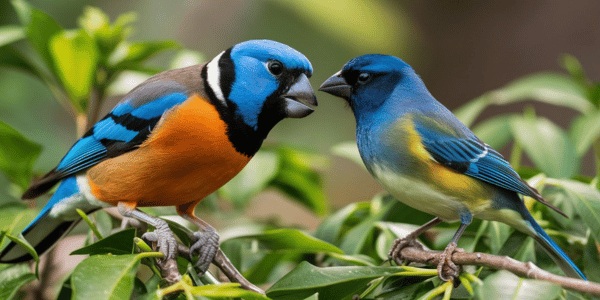





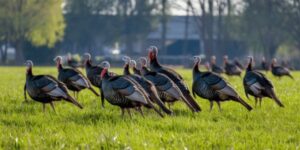

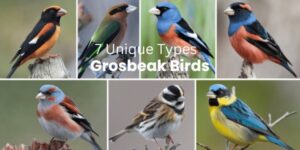

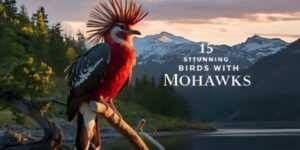
2 Responses